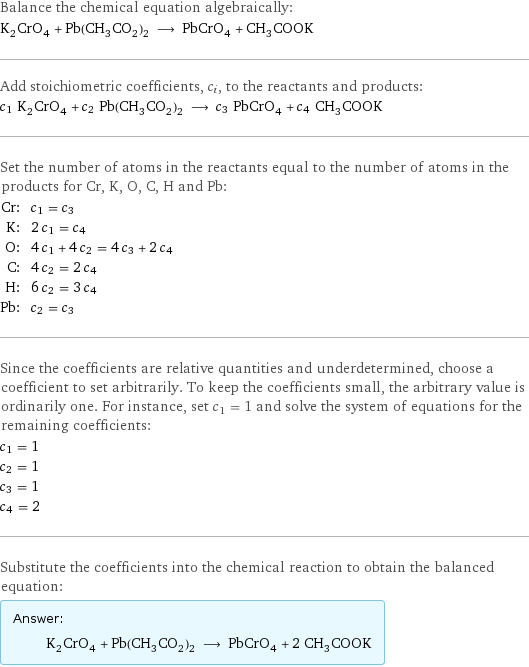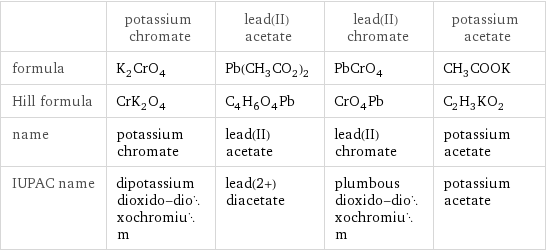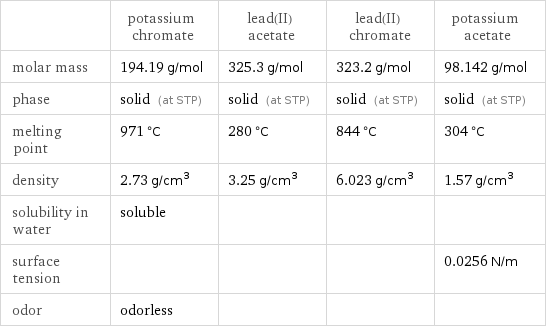Input interpretation

K_2CrO_4 potassium chromate + Pb(CH_3CO_2)_2 lead(II) acetate ⟶ PbCrO_4 lead(II) chromate + CH_3COOK potassium acetate
Balanced equation

Balance the chemical equation algebraically: K_2CrO_4 + Pb(CH_3CO_2)_2 ⟶ PbCrO_4 + CH_3COOK Add stoichiometric coefficients, c_i, to the reactants and products: c_1 K_2CrO_4 + c_2 Pb(CH_3CO_2)_2 ⟶ c_3 PbCrO_4 + c_4 CH_3COOK Set the number of atoms in the reactants equal to the number of atoms in the products for Cr, K, O, C, H and Pb: Cr: | c_1 = c_3 K: | 2 c_1 = c_4 O: | 4 c_1 + 4 c_2 = 4 c_3 + 2 c_4 C: | 4 c_2 = 2 c_4 H: | 6 c_2 = 3 c_4 Pb: | c_2 = c_3 Since the coefficients are relative quantities and underdetermined, choose a coefficient to set arbitrarily. To keep the coefficients small, the arbitrary value is ordinarily one. For instance, set c_1 = 1 and solve the system of equations for the remaining coefficients: c_1 = 1 c_2 = 1 c_3 = 1 c_4 = 2 Substitute the coefficients into the chemical reaction to obtain the balanced equation: Answer: | | K_2CrO_4 + Pb(CH_3CO_2)_2 ⟶ PbCrO_4 + 2 CH_3COOK
Structures

+ ⟶ +
Names

potassium chromate + lead(II) acetate ⟶ lead(II) chromate + potassium acetate
Equilibrium constant
![Construct the equilibrium constant, K, expression for: K_2CrO_4 + Pb(CH_3CO_2)_2 ⟶ PbCrO_4 + CH_3COOK Plan: • Balance the chemical equation. • Determine the stoichiometric numbers. • Assemble the activity expression for each chemical species. • Use the activity expressions to build the equilibrium constant expression. Write the balanced chemical equation: K_2CrO_4 + Pb(CH_3CO_2)_2 ⟶ PbCrO_4 + 2 CH_3COOK Assign stoichiometric numbers, ν_i, using the stoichiometric coefficients, c_i, from the balanced chemical equation in the following manner: ν_i = -c_i for reactants and ν_i = c_i for products: chemical species | c_i | ν_i K_2CrO_4 | 1 | -1 Pb(CH_3CO_2)_2 | 1 | -1 PbCrO_4 | 1 | 1 CH_3COOK | 2 | 2 Assemble the activity expressions accounting for the state of matter and ν_i: chemical species | c_i | ν_i | activity expression K_2CrO_4 | 1 | -1 | ([K2CrO4])^(-1) Pb(CH_3CO_2)_2 | 1 | -1 | ([Pb(CH3CO2)2])^(-1) PbCrO_4 | 1 | 1 | [PbCrO4] CH_3COOK | 2 | 2 | ([CH3COOK])^2 The equilibrium constant symbol in the concentration basis is: K_c Mulitply the activity expressions to arrive at the K_c expression: Answer: | | K_c = ([K2CrO4])^(-1) ([Pb(CH3CO2)2])^(-1) [PbCrO4] ([CH3COOK])^2 = ([PbCrO4] ([CH3COOK])^2)/([K2CrO4] [Pb(CH3CO2)2])](../image_source/f244cb25daafb8ff7a22bbc17d902d80.png)
Construct the equilibrium constant, K, expression for: K_2CrO_4 + Pb(CH_3CO_2)_2 ⟶ PbCrO_4 + CH_3COOK Plan: • Balance the chemical equation. • Determine the stoichiometric numbers. • Assemble the activity expression for each chemical species. • Use the activity expressions to build the equilibrium constant expression. Write the balanced chemical equation: K_2CrO_4 + Pb(CH_3CO_2)_2 ⟶ PbCrO_4 + 2 CH_3COOK Assign stoichiometric numbers, ν_i, using the stoichiometric coefficients, c_i, from the balanced chemical equation in the following manner: ν_i = -c_i for reactants and ν_i = c_i for products: chemical species | c_i | ν_i K_2CrO_4 | 1 | -1 Pb(CH_3CO_2)_2 | 1 | -1 PbCrO_4 | 1 | 1 CH_3COOK | 2 | 2 Assemble the activity expressions accounting for the state of matter and ν_i: chemical species | c_i | ν_i | activity expression K_2CrO_4 | 1 | -1 | ([K2CrO4])^(-1) Pb(CH_3CO_2)_2 | 1 | -1 | ([Pb(CH3CO2)2])^(-1) PbCrO_4 | 1 | 1 | [PbCrO4] CH_3COOK | 2 | 2 | ([CH3COOK])^2 The equilibrium constant symbol in the concentration basis is: K_c Mulitply the activity expressions to arrive at the K_c expression: Answer: | | K_c = ([K2CrO4])^(-1) ([Pb(CH3CO2)2])^(-1) [PbCrO4] ([CH3COOK])^2 = ([PbCrO4] ([CH3COOK])^2)/([K2CrO4] [Pb(CH3CO2)2])
Rate of reaction
![Construct the rate of reaction expression for: K_2CrO_4 + Pb(CH_3CO_2)_2 ⟶ PbCrO_4 + CH_3COOK Plan: • Balance the chemical equation. • Determine the stoichiometric numbers. • Assemble the rate term for each chemical species. • Write the rate of reaction expression. Write the balanced chemical equation: K_2CrO_4 + Pb(CH_3CO_2)_2 ⟶ PbCrO_4 + 2 CH_3COOK Assign stoichiometric numbers, ν_i, using the stoichiometric coefficients, c_i, from the balanced chemical equation in the following manner: ν_i = -c_i for reactants and ν_i = c_i for products: chemical species | c_i | ν_i K_2CrO_4 | 1 | -1 Pb(CH_3CO_2)_2 | 1 | -1 PbCrO_4 | 1 | 1 CH_3COOK | 2 | 2 The rate term for each chemical species, B_i, is 1/ν_i(Δ[B_i])/(Δt) where [B_i] is the amount concentration and t is time: chemical species | c_i | ν_i | rate term K_2CrO_4 | 1 | -1 | -(Δ[K2CrO4])/(Δt) Pb(CH_3CO_2)_2 | 1 | -1 | -(Δ[Pb(CH3CO2)2])/(Δt) PbCrO_4 | 1 | 1 | (Δ[PbCrO4])/(Δt) CH_3COOK | 2 | 2 | 1/2 (Δ[CH3COOK])/(Δt) (for infinitesimal rate of change, replace Δ with d) Set the rate terms equal to each other to arrive at the rate expression: Answer: | | rate = -(Δ[K2CrO4])/(Δt) = -(Δ[Pb(CH3CO2)2])/(Δt) = (Δ[PbCrO4])/(Δt) = 1/2 (Δ[CH3COOK])/(Δt) (assuming constant volume and no accumulation of intermediates or side products)](../image_source/51029b39e768924a967bc1f6d96cc9e5.png)
Construct the rate of reaction expression for: K_2CrO_4 + Pb(CH_3CO_2)_2 ⟶ PbCrO_4 + CH_3COOK Plan: • Balance the chemical equation. • Determine the stoichiometric numbers. • Assemble the rate term for each chemical species. • Write the rate of reaction expression. Write the balanced chemical equation: K_2CrO_4 + Pb(CH_3CO_2)_2 ⟶ PbCrO_4 + 2 CH_3COOK Assign stoichiometric numbers, ν_i, using the stoichiometric coefficients, c_i, from the balanced chemical equation in the following manner: ν_i = -c_i for reactants and ν_i = c_i for products: chemical species | c_i | ν_i K_2CrO_4 | 1 | -1 Pb(CH_3CO_2)_2 | 1 | -1 PbCrO_4 | 1 | 1 CH_3COOK | 2 | 2 The rate term for each chemical species, B_i, is 1/ν_i(Δ[B_i])/(Δt) where [B_i] is the amount concentration and t is time: chemical species | c_i | ν_i | rate term K_2CrO_4 | 1 | -1 | -(Δ[K2CrO4])/(Δt) Pb(CH_3CO_2)_2 | 1 | -1 | -(Δ[Pb(CH3CO2)2])/(Δt) PbCrO_4 | 1 | 1 | (Δ[PbCrO4])/(Δt) CH_3COOK | 2 | 2 | 1/2 (Δ[CH3COOK])/(Δt) (for infinitesimal rate of change, replace Δ with d) Set the rate terms equal to each other to arrive at the rate expression: Answer: | | rate = -(Δ[K2CrO4])/(Δt) = -(Δ[Pb(CH3CO2)2])/(Δt) = (Δ[PbCrO4])/(Δt) = 1/2 (Δ[CH3COOK])/(Δt) (assuming constant volume and no accumulation of intermediates or side products)
Chemical names and formulas

| potassium chromate | lead(II) acetate | lead(II) chromate | potassium acetate formula | K_2CrO_4 | Pb(CH_3CO_2)_2 | PbCrO_4 | CH_3COOK Hill formula | CrK_2O_4 | C_4H_6O_4Pb | CrO_4Pb | C_2H_3KO_2 name | potassium chromate | lead(II) acetate | lead(II) chromate | potassium acetate IUPAC name | dipotassium dioxido-dioxochromium | lead(2+) diacetate | plumbous dioxido-dioxochromium | potassium acetate
Substance properties

| potassium chromate | lead(II) acetate | lead(II) chromate | potassium acetate molar mass | 194.19 g/mol | 325.3 g/mol | 323.2 g/mol | 98.142 g/mol phase | solid (at STP) | solid (at STP) | solid (at STP) | solid (at STP) melting point | 971 °C | 280 °C | 844 °C | 304 °C density | 2.73 g/cm^3 | 3.25 g/cm^3 | 6.023 g/cm^3 | 1.57 g/cm^3 solubility in water | soluble | | | surface tension | | | | 0.0256 N/m odor | odorless | | |
Units
